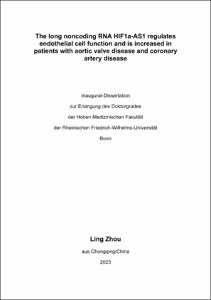Zhou, Ling: The long noncoding RNA HIF1a-AS1 regulates endothelial cell function and is increased in patients with aortic valve disease and coronary artery disease. - Bonn, 2023. - Dissertation, Rheinische Friedrich-Wilhelms-Universität Bonn.
Online-Ausgabe in bonndoc: https://nbn-resolving.org/urn:nbn:de:hbz:5-73602
Online-Ausgabe in bonndoc: https://nbn-resolving.org/urn:nbn:de:hbz:5-73602
@phdthesis{handle:20.500.11811/11189,
urn: https://nbn-resolving.org/urn:nbn:de:hbz:5-73602,
author = {{Ling Zhou}},
title = {The long noncoding RNA HIF1a-AS1 regulates endothelial cell function and is increased in patients with aortic valve disease and coronary artery disease},
school = {Rheinische Friedrich-Wilhelms-Universität Bonn},
year = 2023,
month = dec,
note = {Long noncoding RNA HIF1a-AS1 is significantly dysregulated in different CVDs. However, the specific function and the mode of action of the HIF1a-AS1 are still poorly investigated in CVD. Here, we sought to explore the specific role of HIF1a-AS1 in endothelial cells in context of AVS.
Atherosclerotic stimuli could upregulate the expression of HIF1a-AS1, and knockdown of HIF1a-AS1 in endothelial cells (ECs) increased their effects on cellular function (proliferation, tube formation, angiogenesis). Besides, loss of HIF1a-AS1 promotes Thrombospondin 1 (THBS1) mRNA and inhibits protein expression. Furthermore, the study identified potential Extracellular Vesicles (EV) mediated transfer of HIF1a-AS1 between cells. Notably, the protein THBS1 exhibited distinct regulation upon Endothelial-to-mesenchymal transition (EndMT) depending on HIF1a-AS1 levels.
These findings demonstrate that HIF1a-AS1 regulates ECs function via a THBS1-dependent mechanism. HIF1a-AS1 may regulate protein expression of THBS1 in endothelial cells under EndMT. The role of endothelial dysfunction and EndMT in the pathogenesis of AVS is increasingly recognized. Understanding how HIF1a-AS1 regulates THBS1 in the context of EndMT offers insights into the cellular processes driving valve remodeling in AVS. Modulating HIF1a-AS1 levels or its downstream signaling pathways may help mitigate the progression of AVS, particularly by preventing or reversing endothelial dysfunction and EndMT-related changes.
In summary, this research has the potential to advance our understanding of the disease, facilitate the development of targeted therapies, and ultimately benefit patients suffering from AVS.},
url = {https://hdl.handle.net/20.500.11811/11189}
}
urn: https://nbn-resolving.org/urn:nbn:de:hbz:5-73602,
author = {{Ling Zhou}},
title = {The long noncoding RNA HIF1a-AS1 regulates endothelial cell function and is increased in patients with aortic valve disease and coronary artery disease},
school = {Rheinische Friedrich-Wilhelms-Universität Bonn},
year = 2023,
month = dec,
note = {Long noncoding RNA HIF1a-AS1 is significantly dysregulated in different CVDs. However, the specific function and the mode of action of the HIF1a-AS1 are still poorly investigated in CVD. Here, we sought to explore the specific role of HIF1a-AS1 in endothelial cells in context of AVS.
Atherosclerotic stimuli could upregulate the expression of HIF1a-AS1, and knockdown of HIF1a-AS1 in endothelial cells (ECs) increased their effects on cellular function (proliferation, tube formation, angiogenesis). Besides, loss of HIF1a-AS1 promotes Thrombospondin 1 (THBS1) mRNA and inhibits protein expression. Furthermore, the study identified potential Extracellular Vesicles (EV) mediated transfer of HIF1a-AS1 between cells. Notably, the protein THBS1 exhibited distinct regulation upon Endothelial-to-mesenchymal transition (EndMT) depending on HIF1a-AS1 levels.
These findings demonstrate that HIF1a-AS1 regulates ECs function via a THBS1-dependent mechanism. HIF1a-AS1 may regulate protein expression of THBS1 in endothelial cells under EndMT. The role of endothelial dysfunction and EndMT in the pathogenesis of AVS is increasingly recognized. Understanding how HIF1a-AS1 regulates THBS1 in the context of EndMT offers insights into the cellular processes driving valve remodeling in AVS. Modulating HIF1a-AS1 levels or its downstream signaling pathways may help mitigate the progression of AVS, particularly by preventing or reversing endothelial dysfunction and EndMT-related changes.
In summary, this research has the potential to advance our understanding of the disease, facilitate the development of targeted therapies, and ultimately benefit patients suffering from AVS.},
url = {https://hdl.handle.net/20.500.11811/11189}
}






